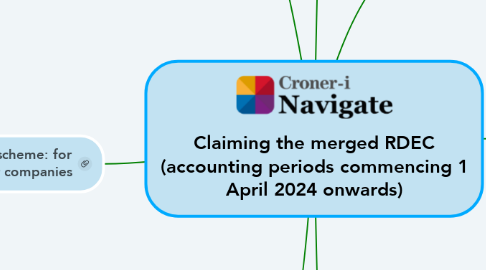
1. Approach
1.1. Understand the rules
1.2. Understand the R&D project
1.3. Collect information
1.4. Perform calculations and provide advice
1.5. Make appropriate claim
2. Other matters
2.1. Other creative tax reliefs
2.2. Insurance companies
2.2.1. Can be treated as carrying on a trade
2.3. Payment
2.3.1. Right to payment cannot be assigned
2.3.2. Payments only made to company / connected person
2.4. Enhanced relief for loss-making R&D intensive SMEs (see separate mindmap)
2.5. Impact on instalment payments
3. Payment of merged RDEC
3.1. Step-by-step approach
3.1.1. 7 steps
3.2. Restricted to 'notional tax charge' if not set against CT
3.2.1. Can be used against future CT
3.3. Subject to PAYE / NIC cap
3.3.1. Treated as future RDEC
3.4. Various group surrender options
3.5. Remainder can be repaid in cash
4. Legislation
4.1. CTA 2009, Pt 13
5. Calculation of RDEC
5.1. 20% taxable above the line credit
5.2. Can be used to offset CT liabiility, surrendered to group companies or in some situations used to generate repayment
5.3. No restriction on subsidised costs
5.4. Pre-trade expenses treated as incurred on day 1 of trade
6. Claiming the merged RDEC
6.1. Must be claimed
6.1.1. Within two years from end of accounting period
6.2. Impact on instalment payments
6.3. Going concern requirement
6.4. Claim notification
6.4.1. Is a notification required?
6.4.1.1. Claiming for first time
6.4.1.2. Last claim was made more than 3 years before last date of claim notification period
6.4.1.3. Previous claim was submitted in the last 6 months of tax return amendment window
6.4.2. Details to be provided
6.5. Additional information form
6.5.1. Must be provided
6.5.2. Details to be provided
6.6. CT600L
6.6.1. Must be completed
7. Single merged scheme: for SMEs and other companies
7.1. As an alternative: loss-making R&D intensive companies can benefit from "ERIS" (Enhanced support for R&D-Intensive SMEs)
7.1.1. Eligible companies may claim merged RDEC rather than ERIS
7.1.2. See separate mindmap for ERIS
7.2. Trading companies only
7.2.1. Above the line credit liable to corporation tax: deemed to be trading income
7.3. Commences with first accounting period commencing 1/4/24 onwards
7.4. Merged RDEC is closely modelled on 'old' RDEC scheme
7.4.1. Key differences from "old" RDEC scheme
7.4.1.1. Lower rate of notional tax restriction at step 2 of payment steps, for small profit-makers and loss-makers
7.4.1.1.1. Lower rate (currently 19%) - where taxable profit < £50,000 exc RDEC claim
7.4.1.1.2. For other companies - notional tax restriction = CT main rate (currently 25%)
7.4.1.1.3. Different rates for ring-fence trades
7.4.1.2. More generous PAYE cap (modelled on old SME cap)
7.4.1.3. Contracted out R&D: new rules - general rule - party who decides to undertake R&D can claim
7.4.1.3.1. Unconnected contractor: 65%
7.4.1.3.2. Connected contractor: up to 100% (group companies sub-contracting can elect to be ineligible)
7.4.1.3.3. Usually, not if undertaken overseas
7.4.1.3.4. Transitional provision: cannot claim if another party is able to claim under old RDEC or SME scheme
7.4.1.4. No claims for contributions to independent R&D
7.4.1.5. (1 April 2023 onwards) data licence costs and cloud computing costs qualify (but not indirect costs)
7.4.1.6. Limitation on relief for overseas externally provided workers
